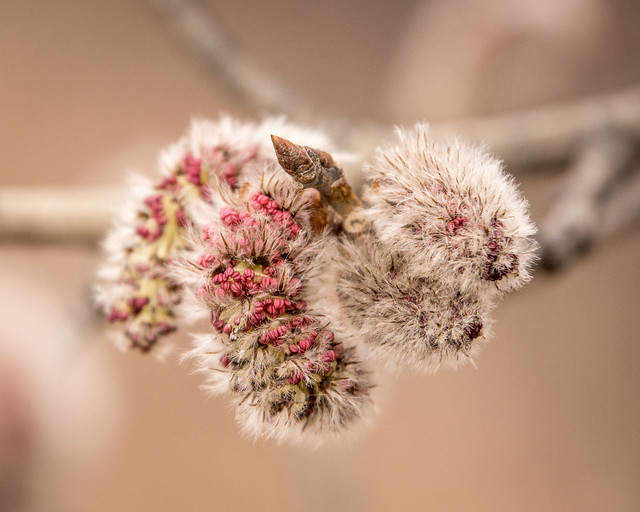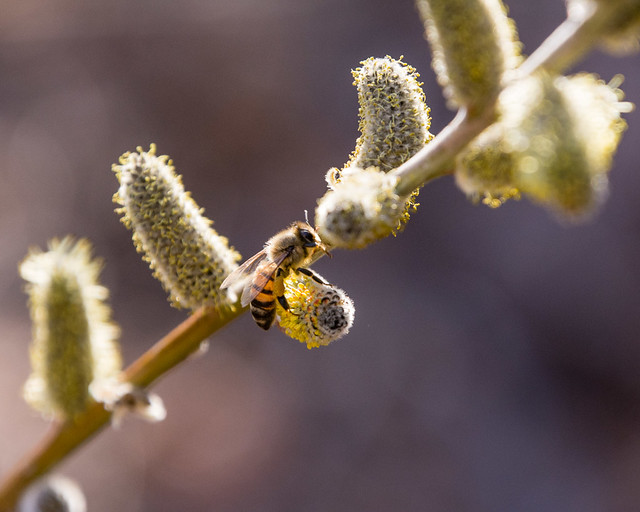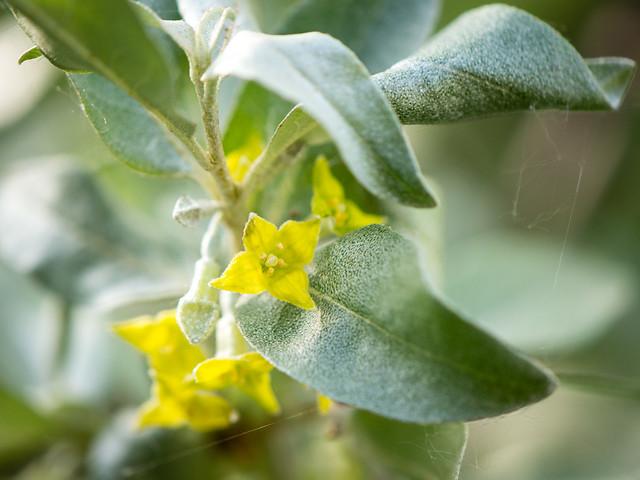Aspen
Aspen prefer cold regions with cool summers (it grows at higher elevations in warmer regions). Trembling Aspen is found throughout Canada and the United States. It’s a slender tree (20-80 ft tall) with heart-shaped leaves that turn yellow in the fall. The leaf stem is flat and set at a 90-degree angle to the leaf, causing them to tremble in even a gentle breeze. Aspen has greenish-white bark with dark ridges on older trees.
Male and female flowers are found on separate trees, appearing before the leaves. The catkins resemble soft caterpillars dangling from the twigs. The male flowers appear first, releasing pollen into the air. The female catkins turn green and form capsules that later release loose cottony seeds.
Did you know? Trembling Aspen's roots send up shoots or suckers and can form large stands of up to 100 acres of identical trees or clones. Individual trunks die, but the roots can live on for hundreds or even thousands of years.
Balsam Poplar is a slender tree with a straight trunk and a narrow crown (65-100 ft tall). The leaves are shiny and dark green with a pointed tip. It’s often found in floodplains as it grows best in moist, rich soil with plenty of sunlight.
Long catkins (3 in) on the male trees are the first to appear in the spring, followed by large, sticky leaf buds that smell of balsam. Balsam Poplar, Aspen, and Cottonwood are members of the same family, which explains why they all produce similar loose cottony seeds.
Did you know? Bees sometimes use Balsam Poplar's resin to disinfect their hives.
Birch (20-70 ft) is common in the temperate and boreal forests of Canada. It has triangular green leaves with serrated edges that turn yellow and then fall in autumn. The bark on mature trees is white and peels in paper-like strips.
Both male and female catkins appear on the same tree, before or at the same time as the leaves. The male flowers dangle from the twigs, while the female flowers are upright and inconspicuous. When the female flower matures, it releases winged seeds.
Did you know? Birch syrup can be made from the sap of the tree. It’s been described as tasting of caramel with a hint of spiciness.
More than 100 species of Willow are native to North America. Willows have long, narrow leaves and thrive in moist soil. Black Willow is North America’s largest native willow (10-60 ft tall). It's a fast-growing tree with several trunks growing out from the root and an open crown. Peachleaf Willow is a medium-sized tree (35-40 ft) and usually has a single trunk.
Male and female flowers are found on separate trees, appearing in early spring just before the leaves. Male flowers are longer and fall from the tree once they've released their pollen.
Did you know? Young willow branches are very flexible and can be used to make baskets, fences, or other objects.
Wolf-willow flowers in late May/June, later than the other trees mentioned but merits inclusion because it has such a distinctive musky-sweet scent. Wolf-willow is a small shrub (under 7 ft) with silver oval leaves and small yellow flowers that mature into silvery berries. Despite its name, it isn’t a willow at all but belongs to the oleaster (wild olive) family.
Did you know? Indigenous peoples of North America used the large, yellow-striped seeds to make necklaces and the fibrous bark can be twisted to make rope.
Nature Companion
You’ll find lots more information about trees and shrubs on EcoFriendly Sask’s Nature Companion, an entry-level nature app for Canada’s four western provinces.
EcoFriendly Sask supports Saskatchewan environmental initiatives through an online publication, an events calendar, small grants, and the Nature Companion website/app.
You can follow EcoFriendly Sask by liking us on Facebook, following us on Twitter, or by email (top right corner).





